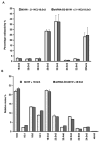Role of Elovl4 protein in the biosynthesis of docosahexaenoic acid
- PMID: 20238022
- PMCID: PMC4350578
- DOI: 10.1007/978-1-4419-1399-9_27
Role of Elovl4 protein in the biosynthesis of docosahexaenoic acid
Abstract
The disk membranes of retinal photoreceptor outer segments and other neuronal and reproductive tissues are enriched in docosahexaenoic acid (DHA, 22:6n3), which is essential for their normal function and development. The fatty acid condensing enzyme Elongation of Very Long chain fatty acids-4 (ELOVL4) is highly expressed in retina photoreceptors as well as other tissues with high 22:6n3 content. Mutations in the ELOVL4 gene are associated with autosomal dominant Stargardt-like macular dystrophy (STGD3) and results in synthesis of a truncated protein that cannot be targeted to the endoplasmic reticulum (ER), the site of fatty acid biosynthesis. Considering the abundance and essential roles of 22:6n3 in ELOVL4-expressing tissues (except the skin), it was proposed that the ELOVL4 protein may be involved in 22:6n3 biosynthesis. We tested the hypothesis that the ELOVL4 protein is involved in 22:6n3 biosynthesis by selectively silencing expression of the protein in the cone photoreceptors derived cell line 661 w and showed that the ELOVL4 protein is not involved in DHA biosynthesis from the short chain fatty acid precursors 18:3n3 and 22:5n3.
Figures




Similar articles
-
Mutant ELOVL4 that causes autosomal dominant stargardt-3 macular dystrophy is misrouted to rod outer segment disks.Invest Ophthalmol Vis Sci. 2014 May 15;55(6):3669-80. doi: 10.1167/iovs.13-13099. Invest Ophthalmol Vis Sci. 2014. PMID: 24833735 Free PMC article.
-
ELOVL4 protein preferentially elongates 20:5n3 to very long chain PUFAs over 20:4n6 and 22:6n3.J Lipid Res. 2012 Mar;53(3):494-504. doi: 10.1194/jlr.M021386. Epub 2011 Dec 9. J Lipid Res. 2012. PMID: 22158834 Free PMC article.
-
DHA does not protect ELOVL4 transgenic mice from retinal degeneration.Mol Vis. 2009 Jun 13;15:1185-93. Mol Vis. 2009. PMID: 19536303 Free PMC article.
-
Current Progress in Deciphering Importance of VLC-PUFA in the Retina.Adv Exp Med Biol. 2016;854:145-51. doi: 10.1007/978-3-319-17121-0_20. Adv Exp Med Biol. 2016. PMID: 26427405 Review.
-
Dominant Stargardt Macular Dystrophy (STGD3) and ELOVL4.Adv Exp Med Biol. 2014;801:447-53. doi: 10.1007/978-1-4614-3209-8_57. Adv Exp Med Biol. 2014. PMID: 24664730 Review.
Cited by
-
Role of membrane integrity on G protein-coupled receptors: Rhodopsin stability and function.Prog Lipid Res. 2011 Jul;50(3):267-77. doi: 10.1016/j.plipres.2011.03.002. Epub 2011 Mar 22. Prog Lipid Res. 2011. PMID: 21435354 Free PMC article. Review.
-
Mutant ELOVL4 that causes autosomal dominant stargardt-3 macular dystrophy is misrouted to rod outer segment disks.Invest Ophthalmol Vis Sci. 2014 May 15;55(6):3669-80. doi: 10.1167/iovs.13-13099. Invest Ophthalmol Vis Sci. 2014. PMID: 24833735 Free PMC article.
-
Acyl-CoA synthetase 6 controls rod photoreceptor function and survival by shaping the phospholipid composition of retinal membranes.Commun Biol. 2024 Aug 21;7(1):1027. doi: 10.1038/s42003-024-06691-8. Commun Biol. 2024. PMID: 39169121 Free PMC article.
-
ELOVL4 protein preferentially elongates 20:5n3 to very long chain PUFAs over 20:4n6 and 22:6n3.J Lipid Res. 2012 Mar;53(3):494-504. doi: 10.1194/jlr.M021386. Epub 2011 Dec 9. J Lipid Res. 2012. PMID: 22158834 Free PMC article.
-
ELOVL4: Very long-chain fatty acids serve an eclectic role in mammalian health and function.Prog Retin Eye Res. 2019 Mar;69:137-158. doi: 10.1016/j.preteyeres.2018.10.004. Epub 2018 Oct 25. Prog Retin Eye Res. 2019. PMID: 30982505 Free PMC article. Review.
References
-
- Aveldano MI. A novel group of very long chain polyenoic fatty acids in dipolyunsaturated phosphatidylcholines from vertebrate retina. J Biol Chem. 1987;262:1172–1179. - PubMed
-
- Bazan HE, Careaga MM, Sprecher H, et al. Chain elongation and desaturation of eicos-apentaenoate to docosahexaenoate and phospholipid labeling in the rat retina in vivo. Biochim Biophys Acta. 1982;712:123–128. - PubMed
-
- Benolken RM, Anderson RE, Wheeler TG. Membrane fatty acids associated with the electrical response in visual excitation. Science. 1973;182:1253–1254. - PubMed
Publication types
MeSH terms
Substances
Grants and funding
LinkOut - more resources
Full Text Sources
Other Literature Sources

